Previously I shared a guest blog from Vinay Bhaskara about the history of Air India. This is a continuation of his story, in his own words:
The Widebody Era
As Air India moved into the 1970s, it was in a wonderful position. Known for its superior service, Air India had managed to catch, not only a huge part of the Indian international travel market, but even a strong share of the Trans-Atlantic traffic between New York and London. They were one of the world’s most profitable airlines, as well as one of the most respected by other countries. Such was the opinion of Air India, that in 1972-1973, Singapore Airlines asked for Air India’s help in setting up its airline.
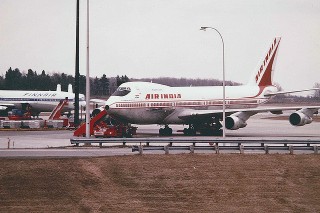
Air India's 747-200B "Samudra Gupta" sits at one of the remote gates at YMX preparing for it's long journey to Mumbai in May 1983. Photo from Caribb.
However, despite Air India’s sparkling reputation and solid operation, change was brewing in the world’s aviation market; change that would require bold action if the Maharaja was to continue in its prosperity. On January 22nd, 1970- Pan Am introduced widebody Boeing 747 service on the London-New York sector. Airlines around the world scrambled to catch up with Pan Am in introducing this new innovation. Despite strong opposition from Air India’s conservative board, there was really never a question in J.R.D Tata’s mind that Air India had to join the ’œ747 club,’ both for prestige reasons, and financial ones (competing as they did with Pan Am on New York-London, as well as European carriers and Asian carriers on the majority of their routes; Air India could ill afford to lose out on the added demand stimulated by lower fares, or the bump in passengers demanding the comfort of the 747). Through almost a sheer force of will, Tata was able to convince the board of the 747’s viability at Air India. Thus it was a moment of personal triumph for Tata when Air India’s first 747-200B (’œEmperor Ashoka’) announced its presence at London on May 24th, 1971, touching down at New York just two days later.
Air India would, at various times, operate 14 Boeing 747-200s, purchasing 11 brand-new from Boeing. During the 1970s, much of the focus was, predictably, on integrating the new aircraft successfully into Air India’s operation. The Boeing 747 presented enormous operational challenges for Air India; its sheer size made much of Air India’s ground equipment, as well as its maintenance and support operations essentially obsolete. Furthermore, while airports at the Londons and New Yorks of the world (where Air India would be operating their aircraft) had the necessary infrastructure in place to handle the Jumbo, taxiways, holding areas, and parking positions at Air India’s international gateways of Bombay and Delhi were woefully inadequate. But in an interesting contrast to today’s situation, the socialist-leaning Indian government of that time quickly acceded to Air India’s demands; building up the necessary infrastructure at not only Bombay and Delhi, but Madras and Calcutta as well. Air India was even able to build brand new maintenance hangars and support buildings at Bombay with a minimum of red tape. Air India’s mechanics at the time had an extraordinary reputation for quick, efficient and thorough quality service; leading many a third world carrier to schedule a stop in Bombay for maintenance purposes.
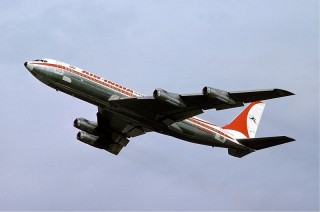
Air India Boeing 707. Photo from Wikipedia.
Given the enormous complexity added to Air India’s operation by the 747s, it is not surprising then that the airline limited its expansion during the first half of the 1970s. The first priority was to upgrade their highest-traffic routes to the 747s. By the summer of 1978, that goal had been achieved- with daily service to New York JFK, double daily to London-Heathrow (one of which continued to New York JFK), and daily service on the Tokyo route all performed on the 747-200Bs. During this transitions period, Air India wisely restricted its network growth; simply adding new destinations close in. The most notable of these was service to Dhaka, capital of the (relatively) new nation of Bangladesh. Service to Dhaka on 707s was begun on February 4th, 1972 and in November of that year; Osaka was added as an intermediate stop to the Tokyo route. Meanwhile, the Gulf market continued to grow in leaps and bounds, as new found oil wealth drove Middle Eastern nations to import migrant South Asian workers in droves. The important oil destinations of Muscat and Doha were added during the mid 70s, and frequencies to Gulf points increased heavily. Later in the decade, Baghdad and Ras al Kaminah also joined the Gulf portfolio. African growth was more limited, with mid-decade additions of the Seychelles (on the Mauritius route), Lagos, and Accra.
To this date, very few aviation entrepreneurs have been as involved in the day to day operations of their airline as J.R.D Tata. Air India’s scion, who had guided Air India to profitability in all but 3 years during his tenure, was one of the aviation industry’s foremost personas; on par with C.R Smith of American Airlines or Eddie Rickenbacker at Eastern Air Lines. However, in early 1978, it was announced that Tata would be stepping down as chairman by the end of that year. Before he exited however, Tata made one final mark on the aviation world; proving that he still had one of the sharpest minds in all of India. In a landmark speech on the 23rd of January 1978, Tata predicted that in the future, there would be a twin deck 750 seat mainline aircraft, that a long haul, low cost carrier akin to Laker Airways would flourish, and that future growth rates in the airline travel industry would average around 6%. He also cast doubts on the viability of the Concorde.
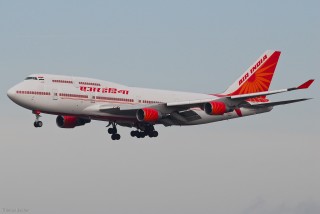
Air India still flies the Boeing 747 today. Photo by Thomas Becker.
On all four points, he was eventually proved correct (Airbus A380, AirAsia X, the test of time, and just 20 built). Having thus left his mark on Indian aviation, Tata rode off into the sunlight (literally- he re-enacted the first Karachi-Mumbai flight flown by Air India using an old Leopard Moth) and let his successor P.C Lal take the helm. The last two years of the decade provided very little in way of expansion; the major change was the introduction of direct services between South India and the Gulf. The majority of migrant workers in the Middle East were from Southern India, and Air India recognized this by introducing nonstop services- the first of which was Trivandrum-Dubai in 1978. Gulf routes represented the majority of Air India’s expansion in the latter half of the decade, and when Raghu Raj took over as chairman in April of 1980; Air India’s route network looked much as it did in 1975.
While Air India soared to great heights with the 747, Indian Airlines was entering the widebody age as well, though not on as grand a scale. Indian entered the 1970s as a troubled carrier. Of its numerous problems, a few were common with other airlines, but most were especially because of Indian Airlines’ home country; India. While these problems were certainly not insurmountable alone, when taken collectively, they represented a significant handicap to Indian Airlines’ progress.
* Indian Airlines was faced the constant threat of local wars between Pakistan and India. As the internal national carrier; Indian Airlines was responsible for providing transport and logistics during major conflicts. Therefore, operations were often interrupted, and lengthy periods existed where Indians traveling between cities had to divert to rail connections. Flights to rescue refugees (such as in Uganda in 1972) were less prevalent, but still diverted the carrier’s resources (Indian Airlines was required to perform these flights for free).
* As was common with national carriers, Indian Airlines was required to provide social services to underdeveloped and poor regions. These routes were rarely, if ever, subsidized by the government, and Indian Airlines was forced to cross-subsidize these routes with more profitable, big-city services; seriously depressing financial results. (Interestingly enough, one of the arguments in the recent Emirates and Canada brouhaha was that Emirates should not be given access to Canada because that would harm Air Canada’s international services, which supposedly cross-subsidized domestic routes to remote locations)
* As a corollary to the statement above, Indian Airlines was forced to serve multiple unprofitable points in the Northeast of India, where diversions due to a necessity to avoid East Pakistan (what Bangladesh was called before it got its independence, which in 1971 solved the to-be-mentioned problem) caused Indian Airlines’ fuel bill to become unsustainably high
* India as a market has always faced high fuel prices ’“ thanks to import duties, sales taxes, and a lack of domestic production. For Indian Airlines, the high price of fuel heavily limited profitability, especially when the carrier was flying a (relatively fuel inefficient fleet).
* When the IAC was formed in 1953, labor rates in India were abysmally low (a by-product of India’s previously colonial-style economy). But due to Indian Airlines’ high structural costs, the airline could ill-afford to satisfy its employees’ demands for higher wages. With little wage growth, strikes and work stoppages were common; disrupting operations further.
* As a by-product of a merger of 8 different carriers, Air India had multiple maintenance bases (4; Bombay, Delhi, Chennai, Calcutta). This complicated scheduling, and increased costs by a significant margin. When coupled with the aforementioned strikes; it is safe to say that Indian Airlines did not have the same operational reputation as Air India.
Given this veritable laundry list of problems, it is surprising that Indian Airlines was even able to survive at all. It really is a credit to the airline’s spirit at that time; and Indian Airlines showed a resiliency that would sustain it till the very end (a.k.a the merger with Air India in 2011).
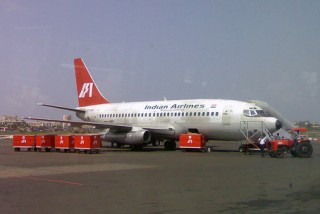
Indian Airlines Boeing 737-200. Photo by Tripping in India
The years 1971-1973 were very bad for Indian Airlines. The 1971-1972 Pakistan War caused operational interruptions and numerous problems, as mentioned above. This led the airline to report a 45 million rupee loss in 1973, the carrier’s largest to that point. And that may have been the best news to come out of 1973; as a series of crashes and work disruptions made life for Indian Airlines a ’œliving hell.’ On May 31st, a 737 crashed in a fierce Delhi storm, while a Caravelle, 2 HS 748s, and a Friendship all had to be taken out of service as well. But in spite of heavy scheduling demands, Indian Airlines was slow to put these aircraft back into service due to the illogical structure of their maintenance operations.
Exacerbating the aforementioned crises was the continual strike being waged by labor. Management, concerned by growing labor costs and inefficiency, eventually locked out many of its workers, operating only a skeleton schedule with a non-union workforce. It was against this backdrop that Indian Airlines ended the Night Air Mail Service, a service utilizing Nagpur in Central India as a hub to exchange mail between major Indian cities, after 24 years of continuous service. Additionally, all but two of the Vickers Viscounts were retired; all but ending the service run of India’s first true mass-transport aircraft. Eventually, Indian Airlines negotiated a new deal with its staff that kept wages flat while simultaneously making work rules and management-labor interactions more flexible.
With the labor situation stabilizing, Indian Airlines then moved to improve the financial performance of its operations. On February 1st 1974, fares were increased by 25% across the board; an action that was followed by the retirement of the last 30 Douglas DC-3s. The DC-3s had been present since the formation of Indian Airlines, and had served a variety of purposes; serving small dirt and gravel strips, performing airlifts and refugee flights, and acting as a quick substitution for Indian Airlines’ numerous aircraft losses. While fuel costs were certainly high with the DC-3s, the reliability of the aircraft was top-notch and no other aircraft could perform the DC-3’s exact function. This unique versatility was corroborated by the fact that upon the retirement of the DC-3s, 16 stations previously served by Indian Airlines were entirely closed down, as the Fokker Friendships could not reliably operate into these airports.
The dramatic sideshow of Indian Airlines’ regional operations sometimes overshadowed the fact that the carrier served a growing demand base on its trunk routes. Throughout the middle part of the decade, Indian Airlines re-grouped and stabilized, allowing it to take the bold and historic step of ordering 3 Airbus A300 widebodied aircraft in April of 1975. These aircraft would be used on Indian Airlines’ primary trunk routes, on which the 737s were regularly traveling full.
Recognizing that domestic demand in India was more about volume than premium business, Indian Airlines planned for the new Airbuses to be configured in a 278 seat all-economy class offering, with 33 inches of seat pitch. Even with demand booming however, widebody aircraft were very expensive to acquire and operate, so Indian Airlines smartly negotiated a deal with Airbus to reduce the price of the aircraft by a collective $2.4 million by shifting the manufacture of key ground service components to Indian factories.
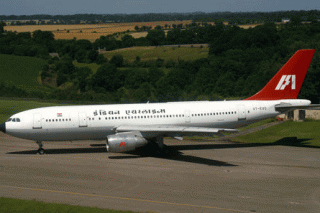
Indian Airlines Airbus A300.
External events caused the new A300s to be delivered much earlier than planned. In October of 1976, yet another Caravelle had crashed; causing the entire fleet to be grounded temporarily. Thus, Indian Airlines inaugurated service of the A300B-2s on December 1st of that same year, taking delivery of all 3 initial frames by mid January. These aircraft quickly began serving the Bombay-Delhi-Calcutta-Madras ’œdiamond,’ as well as Bangalore, stretching the 3 aircraft to their utilization limits. Loads were very good, consistently surpassing the 90% mark, and on-board service was upgraded a notch with more flight attendants per seat and a new selection of fine Indian cuisine.
Indian Airlines was primarily a domestic airline; with the vast majority of its flights operating within the confines of India’s 28 (+7) states. But given the fluid political situation of the Indian sub-continent; it was deemed better for Indian Airlines to provide air services to India’s immediate neighbors; namely Pakistan, Nepal, Bangladesh, Afghanistan, Burma, and so on. Keeping Air India on longer haul routes ensured that the valuable Air India brand was not tainted by unrest on the sub-continent. But for Indian Airlines, its international services were a point of pride, and so the carrier faithfully restored service to Karachi, Lahore, Dhaka, Kabul, and the like after every conflict. Given the state of the region’s other national carriers, such as PIA, Biman, and Ariana; Indian Airlines often represented the first step in normalized relations in the subcontinent. International operations grew in scale, albeit slowly, and by the end of the decade Indian Airlines was serving Dubai and Muscat in the Gulf.
Thus concludes Part 2 of the history of Air India. At this point I’d like to give a huge shout out to perhaps my best source; Airlines of Asia by R.E.G Davies. While I’ve certainly used other sources to write this piece; the basic events, and the idea for the story were both based on Mr. Davies’ book. R.E.G Davies is perhaps the greatest aviation historian of all time, and I encourage you all to find more of his books. It would be a great way to pay homage to his memory (Mr. Davies passed away on July 30th of this year).
This a guest blog from Vinay Bhaskara looking how airline and train transportation has changed over time on the east coast. This is his story:
One of my more ’œavgeeky’ hobbies is looking at the Form 41 data; specifically the T100. The T100D Segment, which I’m going to be looking at today, gives us data about every domestic flight operated by all carriers, both US owned, and international.
Now the T100 database at the DOT goes back to 1990, so I decided to take a look at how a specific route looked like in 1990, and then in 2009 (the second to last full year of data available). After a few moments of debate, I decided on New York La Guardia to Washington Reagan ’“ one component of the venerable Northeast Shuttle.
The La Guardia to Reagan route is still one of the most traversed air routes in North America, comprising 423,483 passengers last year. There are only two airlines on the route; US Airways, and Delta. In 1990, it was the legendary Pan Am who flew the route in lieu of Delta. That being said, here are some of the stats I found most interesting:
* Capacity on the route fell by 49% and passengers dropped 50%. So in 19 years, the airlines have halved their capacity on the route, and half as many passengers are flying the route.
* Despite the precipitous drop in capacity and demand, the average number of daily flights only dropped from 31 to 24.
* This corresponds with the average aircraft size falling from 159 seats in 1990, to 103 seats in 2009. Of course this probably has a lot to do with the fact that Delta is running E175s every hour, but still.
* Delta had a load factor of 40% last year. I hope they have lots of high yielding passengers, because they sure as heck aren’t filling many seats.
The following chart shows how the capacity and passengers carried stacked up for each airline:

The next two charts show the corresponding market shares of the different airlines. Isn’t it surprising that Delta (who replaced Pan Am on the route in 1991) lost so much market share?

Why are the passenger numbers dropping so much? In a word: time. The time it takes to fly between New York and DC has grown so much, that flying has become far less attractive, especially when compared to other options like the Acela Express.
Still skeptical?
Let’s take our average businessman, and say that he lives 20 minutes away from both Penn Station and La Guardia (I’m not sure there is such a point, but work with me here). So we start with that. Then, the Acela Express takes an average of 3 hours to reach its destination, and bam, you’re in downtown DC at Union Station.
The flight on the other hand is much more complex. After arriving at the airport, you usually have to budget time for security. I’d estimate it to be 15 minutes at the Marine Air Terminal (Delta Shuttle) during peak times, and 40 minutes at US Airways’ terminal during the same time period. So let’s assume that it takes around 30 minutes for security. Then, you want to be at the gate around 25 minutes before your flight; which brings you to a total of 75 minutes before you even board the flights. Now, the average ramp to ramp time, which is how long it takes for the plane to go from gate to gate was 73 minutes last year. Once you arrive at the airport, we can figure around 10 minutes for disembarking and going to the taxi stand/limo pickup. From Reagan National, it usually takes around 25 minutes to get to downtown DC by car. So let’s tally up the total travel time for each method.
Acela Express
Drive to Penn Station- 20 minutes
Train Travel Time- 180 minutes
Total Travel Time- 200 minutes
US Airways and Delta Shuttles
Drive to La Guardia- 20 minutes
Security at Airport- 30 minutes
Time at Gate Prior to Departure- 25 minutes
Plane Travel Time- 73 minutes
Time to Get out of Reagan Airport- 10 minutes
Drive to Downtown DC- 25 minutes
Total Travel Time- 183 minutes
Plus, the service on the Acela Express is much better. Acela Express- Spacious seats, in-seat power, WiFi, a newspaper, and gourmet meals. US Airways/Delta Shuttle- Cramped cabin, snack boxes, free drinks, and a newspaper. You decide’¦.. Which one would/do you choose?
Vinay Bhaskara is an aviation analyst and history buff based in the United States (New Jersey). In addition to his analyst’s position at Aspire Aviation, he also writes for the Bangalore Aviation blog, and does a podcast on Asian aviation with Innovation Analysis Group (IAG). He can be reached at @TheABVinay on Twitter, as well as at vi***@ba***************.com, on Facebook , and via Linkedin.
While I was gone recently, a very motivated young man, Vinay Bhaskara, asked if I might want him to write up a guest post about Air India. When I said I would love one, I had no idea he would be so detailed and really re-construct the history of the airline. Things kept popping up and I wasn’t able to share his multi-part story until now.
Bhaskara is a teen-aged aviation enthusiast and blogger. His blog is hosted at Flyertalk (The Gate). He can be found on Twitter (@TheGateVinay), as well as Facebook and Linkedin. His podcast on Asian aviation should also be launching soon. Here is his story on Air India in his own words:

Air India's first aircraft was the de Havilland Puss Moth.
The Air India Story- Part 1
Air India is one of the most confounding airlines in the world today. Once India’s flag-bearer to the world; the aging carrier has slowly disintegrated into the mess currently grabbing headlines today. Such staple routes as Tokyo, Frankfurt, and London just aren’t making money for the carrier; a far cry from the days when they brought the Indian flag to every inhabited continent on the globe except South America. But in order to understand its current problems; it would be helpful to take a look back into the past.
The Early Days
Air India (and its former domestic partner Indian Airlines) has its roots in the vision of J.R.D Tata; India’s first true business scion. Tata was a director at Tata Sons Limited; one of Asia’s largest industrial companies. In July of 1932, he created an aviation department at the company; and began the first un-subsidized (ie: no mail contract from the British) domestic air service in India after receiving a license for through flights between Madras (Chennai) and Karachi via Bombay (Mumbai) on October 15th, 1932. The route, which also stopped in the commercial city of Ahmedabad gave South India an important link into the airline network in Bombay. The initial fleet consisted of 2 Puss Moths; a 2-3 seat propeller aircraft. Such was the success of the carrier that they added an additional Fox Moth; a larger cousin of the Puss Moth that could carry 3-4 passengers, within a year.
By 1935, a technical stop in Bellary had been replaced by a passenger stop in the more important Southern city of Hyderabad and overall frequency had doubled from once weekly to twice. New routes were also on the radar of the rapidly growing carrier; November of 1936 saw service being expanded from Bombay to Trivandrum via Goa using a 5 seat Miles Merlin, which Tata had used to replace the Puss Moths. By 1937 a route to Delhi (via Indore, Bhopal, and Gwalior) had been started and in 1938 the route to Madras was extended to Colombo, Sri Lanka. Tata Airlines’ business got a big boost during this period from a mail contract with the British Empire Air Mail Scheme, under which all First Class Letters between Karachi and Colombo (and all points served in between) were carried by Tata Airlines at ordinary postage rates (on a pound-mileage basis). By 1939; Tata Airlines was operating a fleet of 8 passenger D.H.89s and smaller types from the American manufacturer Waco; in that same year- the carrier bought two 12 seat D.H.86s from Mac.Robertson-Miller Airlines in Australia. But due to the outbreak of World War 2; J.R.D Tata was unable to take Tata Airlines to greater heights.
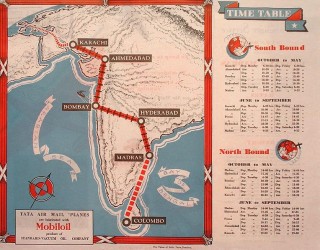
TATA's time table during the summer of 1935. Photo from Wikipedia.
During World War 2; the growth in new routes slowed for Tata Airlines. But because the War was relatively docile in India; demand on existing routes continued to grow. They upgraded their fleet constantly; eventually jumping up to a fleet of 3 Stinson Model As, as well as multiple 14 seat Douglas DC-2s. This new lift helped Tata spread its wings to Bangalore, Nagpur, Calcutta, and even Baghdad, Iraq by June of 1945 (nearing the end of the war).
Following the end of the war; Tata Airlines switched its emergency (ie: for war) route permits with actual route rights from the government. All routes were confirmed by June; and Tata was given access to war surpluses; resulting in a large fleet of at least 12 Douglas DC-3s; an aircraft which formed much of the fleet of Asian carriers in the 1950s. On July 29, 1946; Tata took his company public; and the carrier was re-named Air India Limited. In April of 1947; Air India received the first of 4 35-seat Vickers Vikings; for use on the larger routes in their network. As Air India continued to grow; it became a government owned corporation in March of 1948; later that month they received their first Lockheed Constellation; a large turboprop.
Running in parallel to the expansion of Tata Airlines were a few other Indian domestic carriers; such as Indian National Airways (INA) and Air Services of India (ASI); both of which had domestic networks rivaling that of Air India Ltd. Smaller private players abounded as well; Bharat Airways’ network extended all of the way to Bangkok, Hong Kong, and Singapore. As the government searched actively for ways to strengthen the Indian aviation industry; the nationalistic undercurrents in Indian politics called for a single national domestic airline. They got their wish on June 15th, 1953 when all Indian domestic carriers; as well as the domestic arm of Air India Ltd. were merged to form the Indian Airlines Corporation. The resulting carrier had a fleet of over 100 aircraft; ¾ of which were DC-3s, as well as a dozen each of the larger DC-4s and Vickers Vikings. Air India Ltd. was re-organized as Air India International (AII- later shortened to Air India), and given exclusive rights (amongst Indian carriers) to carry long-haul international traffic.
*From this point on; the stories of Air India and Indian Airlines will be told in parallel.
The Expansion
Before losing its domestic operations to Indian Airlines, Air India had also pursued its own international expansion. Soon after receiving the first Constellation, Air India introduced service to London; by way of Cairo and Geneva. Despite strong initial demand however, Tata was cautious, and he limited Air India’s initial international expansion to London and Nairobi (via Aden, Yemen) with its large ethnic population of Indian businessmen. But progress was not to be held back. The London services quickly jumped in frequency to 3 flights per week and new European points were added quickly to the London route; Rome, Paris, and Dusseldorf. Though Air India grappled with the time savings of the new Comets flown by BOAC (they even ordered a pair); they fought back with superb on-board service. Air India was especially beloved for the humorous little booklets it handed out to every passenger; with such useful information as how to (not) steal cutlery and a reminder not to stuff children in seat-back pockets.
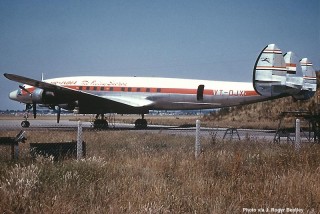
An Air India Super Constellation (VT-DJX) Photo by: J. Roger Bentley
Despite the lack of jet service to compete with BOAC; marginal improvements came with Lockheed’s L-1049 Super Constellations; which were placed on the London route in 1954. By 1960; the London route included Beirut, Zurich, and Frankfurt (which had replaced Dusseldorf. But in addition to an expansion of European service; Air India was turning its eyes eastward; to the Orient. Within a few years of full nationalization (1953 in parallel with Indian Airlines); Air India had opened routes to Singapore, Hong Kong, and Bangkok. The Singapore route was quickly extended to Australia (Sydney by way of Darwin); picking up traffic stops in Kuala Lampur and Jakarta along the way. Because of the violence in Egypt during the Suez crisis of 1956; Air India also developed an alternative route to Europe (Moscow by way of Tashkent); which could be extended to Western Europe if necessary. As the 50s drew to a close; Air India had grown from infancy into a full-fledged international carrier; with wide-ranging operations in Europe and Asia, as well as important toeholds in Africa and Australia. It was the latter that allowed Air India to take advantage of a lucrative business opportunity in the late 1950s; it leveraged its important position on the Kangaroo route to launch a revenue-sharing agreement with Qantas and BOAC (sort of a pre-precursor to today’s JVs) on service between Europe and Australia.
Meanwhile; Indian Airlines had been quietly dealing with problems of its own; mainly related to the fact that 8 airlines; with differing operations, had been squished into 1. Especially problematic was the redundancy in jobs; the airline had 2-3 times as many employees as necessary- resulting in a bureaucracy of staggering inefficiency. The attrition process would take many years and was never fully completed (see Air India’s current situation). Furthermore; the fleet of DC-3s was maintained haphazardly; with quality in certain shops shockingly bad (to put it mildly). This in and of itself was a more fundamental problem; as a carrier with a reputation for being unsafe could not be expected to gain flying passengers from the nation. When coupled with a bevy of unsafe airports (unpaved runways etc.), at least 17 resultant accidents involving DC-3s took place in the first 3 years of Indian Airlines. But while Indian Airlines grappled with these problems; they also moved to modernize the fleet. Five Vickers Viscount 768s were ordered for the main trunk lines and 8 de Havilland 114 Herons were introduced onto feeder routes.
During the 1950s; Indian Airlines set its network into a pattern that would be followed till the 1990s. The major trunk lines (especially those connecting ’œThe Diamond’- India’s 4 largest cities; Bombay, Calcutta (Kolkata), Delhi, and Madras) were operated with the largest aircraft. Initially, they were served with Vickers Vikings; but trunk routes quickly shifted to pressurized Viscounts in 1957. Secondary routes were served initially with DC-3s; though even these routes could be differentiated into two tiers (Tier 1: mid-sized Indian cities with modern airport facilities, Tier 2: small Indian towns with rudimentary airstrips). As Indian Airlines shifted into the 1960; their main fleet problem became dealing with a replacement for the ageing DC-3s. The venerable Dakotas were the only airliner that could operate on rudimentary grass and gravel strips; so common in India’s economically backwards Northeast region. Replacement for Tier 1 cities was easy but the fate of Tier 2 stations remained to be seen. Two manufacturers had offerings in the 40-44 seat turboprop market; the Fokker F-27 Friendship and the Avro 748 (later Hawker-Siddely 748s). The HS-748, with its low wing design, was considered the better aircraft for operations into Tier 2 markets, so India negotiated a deal from which HS-748s would be built at Kanpur, India. However, given India’s notorious problems with business, Indian Airlines also decided that it couldn’t wait for the HS-748s for Tier 1 replacement and simultaneously order F-27 Friendships as well. These aircraft were delivered in 1961 (a full 6 years before the first HS-748), and began plying routes across India. But even after delivery of both types; neither was able to replace the DC-3s on the smallest dirt and gravel strips; meaning that the DC-3s stayed in the fleet until 1974.
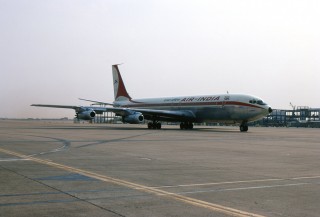
Air India Boeing 707 (VT-DJK) taken in London (LHR) in April 1969. Photo by Sir Hectimere.
While Indian Airlines was grappling with tough fleet choices; sister Air India entered the jet age. When the Boeing 707 entered service in 1958, they quickly revolutionized air travel with their (relatively) quiet and fast service. Air India was no different than most carriers, and placed their first Boeing 707 on the London route in April of 1960, and in May of the same year, hit a milestone with entry into service between London and New York; becoming the first Asian airline to serve NYC. Air India was considered one of the most luxurious airlines in the world; with its unique brand of Indian service creating popularity not only from New York to India; but even on the trans-Atlantic crossing. Much of Air India’s extraordinary service reputation during the 60s and 70s was the result of the work of Bobby Kooka, a marketing executive whose credits include the venerable Maharaja logo (the symbol of Air India).
By 1962, the 707 had replaced the Constellations (which were converted to cargo service) on the routes to Tokyo, Australia, Africa, and Europe; Air India was now an all-jet airline. Throughout the 1960s; Air India rationalized its network to fit the changing airline world. The advent of jet travel allowed more routes to be operated than ever before. This led Air India to de-couple much of its European network (though almost all flights ended in London), and add service to more points in the Gulf and beyond. By the second half of the decade; Air India had begun to shift its network to meet the needs of the changing overseas Indian population. Flights to Europe declined in importance, as the 707 allowed Air India to expand its network. The island destinations of Fiji and Mauritius, where Indians composed 50% or more of the populations, entered in 1964 and 1967 respectively. In 1968 they added Entebbe and Addis Ababa as African points; both containing sizeable Indian population. But these additions could not compare to the sudden boom in Indian population that was taking place just across the Arabian Sea. The Muslim countries of the Gulf were experiencing an oil boom, with their economies growing in the double digits each year. In order to service this growing wealth, these countries imported hundreds of thousands of laborers from South Asia to build up their infrastructure and serve as domestic servants. While these laborers were not supremely wealthy, they did constitute a source of new and growing demand. Recognizing the need for direct India-Gulf services; Air India began operating to many Gulf points as stand-alone destinations. Dubai, Abu Dhabi, and Dhahran soon showed up on the route map; and such was the demand for Air India’s services that they even chartered a Vickers VC-10 from BOAC to service Kuwait. Air India’s 11 Boeing 707s stayed in the fleet until the 1980s; operating on secondary routes and serving as a valuable tool in opening new services.
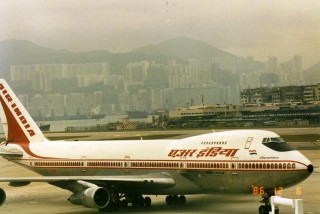
Air India Boeing 747-200 (VT-EBO). Photo by Savvas Garozis.
Indian Airlines too was quick to enter the Jet Age. The Friendships had been successfully deployed on secondary routes, but it had quickly become apparent that the Viscounts were far too small for their main trunk routes. Two choices were possible; the British Trident and the French Caravelle. The Caravelle; with its bold rear-engines was the world’s first short-haul jet and it had served Air France with distinction. The Trident, on the other hand, was a paper airplane that carried only a few more passengers than the Caravelle with far more inefficiency. The Caravelles entered service on Indian Airlines’ trunk routes by 1964, equipped with 89 all-economy seats. In spite of the Caravelle’s extraordinary performance (Indian Airlines achieved annual utilization of almost 3,000 hours per aircraft- among the best in the world), problems with accidents persisted; and Air India lost 2 Caravelles in 1966. By 1968/69 Indian Airlines was in a severe capacity crunch (though the HS-748s helped some); further exacerbated by extraordinary demand on their trunk routes (which the Caravelles couldn’t fill). So in 1970, Indian Airlines won approval from the government to order a larger jet. The 125 seat Boeing 737-200 won the contract and 7 frames were ordered in 1970. However, this order was not without controversy; as the Douglas DC-9 and the BAC 1-11 were both in contention. The complicated and messy battle ended with the 737-200’s selection; and Indian Airlines received an aircraft that would remain the workhorse of its fleet into the 90s.
Thus concludes part one of The Air India Story; which covered the dual story of Air India and Indian Airlines from ~1930 till 1970. Part 2 will cover the B-747 era, as well as Indian Airlines into the 2000s. Part 3 will cover the current situation at Air India and its possible solutions
Image Citations:
de Havilland from Air India
Route map from Wikipedia
Constellation by J. Roger Bentley
Boeing 707 by Sir Hectimere
Boeing 747 by Savvas Garozis











